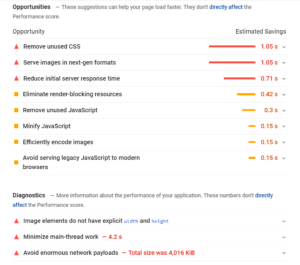Over 57% of B2B marketers believe that SEO generates more leads than any other marketing gimmick.
Indeed, SEO is one of the most promising digital marketing techniques of all times. But is it easy to make it work?
Well, SEO can often be easy, but it’s not always simple — especially when you are just starting out. Promoting your business website through SEO requires an air-tight implementation of the right strategies.
In this article, we are discussing the first six steps that can help you effectively begin your website’s SEO journey. So, whether you are looking to boost your site’s organic traffic or to generate qualified leads, this post will help you.
Many marketers don’t pay much attention to page speed at the start of their SEO campaigns. However, good page speed is one of the most important and quickly achievable SEO targets, so it makes sense to start with it.
The first thing you need to do is check your website’s page speed score.
For that, you can use tools like Google PageSpeed Insights or GTMetrix.
Once you are on any of these tools, paste your website URL and hit enter. This will take you to the results page where you can find a detailed report about your website’s page loading speed as in the screenshot below.

Once you have this report, you can start resolving page speed issues one-by-one.
Remember: Fixing page speed may require technical know-how of working with the cPanel. If you lack the knowledge, contact a reliable web design company in Greenville.
Even though we believe in nascent innovation and fresh ideas, there’s a lot that we can learn by looking at our competitors.
From identifying popular keyword trends to finding evergreen link-building opportunities, competitor analysis can do it all for us. But first, we need to know who our competitors are.
So, take a pen and paper and start noting down the names of businesses in your industry. It’d be best to also categorize them based on their market cap.
This will help you find out who is your direct competition and who you may have to compete with once your business scales up.
Once we have a list of our direct competitors, we’ll need to analyze their websites for their SEO strategies and keywords.
Now, this can be done in two ways.
Either you can purchase premium subscriptions of SEO tools like Ahrefs & SEMRush, or hire a digital marketing company. In most cases, the company will have premium subscriptions, so you wouldn’t have to shell on that.
This will provide you with relevant and volume-rich keywords to start off your SEO campaign.
After that, we’ll analyze competitors’ content strategies. By finding out their most popular content formats, we can either follow their footsteps or bring our own content ideas to life.
The aim is to create search engine optimized content pieces that can shoulder your competitors in the search engines.
Remember: Regular posting is important for SEO.
Let’s consider an example.
There are two websites (‘website A’ and ‘website B’) functional in the same niche with similar domain value. While the content, title tags, and meta data on ‘website A’ is optimized with relevant keywords, ‘website B’ lacks such optimization.
Which website do you think has a higher chance of performing better in the SERPs?
Your web pages’ meta descriptions, title tags, image alt-texts, and descriptions matter a great deal in the search engine.
Even if your website manages to rank higher in the SERPs without a meta description, it may not acquire enough organic clicks. A web page’s meta data is a label that helps the audience and search crawlers know what the page is about, so optimize it.
It’s been a long time since Google has been boasting about how internal links are important for SEO.
From improving website navigation to boosting page rank, internal links do it all.
The question that crops up is, “what is the correct way of interlinking your content pieces?”
For that, here’s the answer.
As you are creating content on a regular basis, it also makes sense to share it with your audience.
To start with, you can share your important pages on your brand’s social channels. This may give your business some exposure and initial traffic.
Apart from that, start working on your first guest posting campaign.
You can take a target of publishing three to four guest posts in the first week or till the next fortnight.
This will help you build relationships with fellow bloggers, expand your circle, and know people in your niche. Plus, your website may also start receiving backlinks directed towards your target pages.
If you lack guest posting experience, our team at Radical would love to help you.
SEO can often be an elongated process. Even with a good budget, results may take time to show. However, there has to be a starting point, and in this article, we tried to define one for our readers.
Here you got to read about the first six steps that can help you launch off your first successful SEO campaign.
Hopefully, this was helpful.
Understand what our clients already do about our unmatched dedication to client success.


Videos and Content Pieces
Developed Every Month
Percent Growth Month
Over Month
Years of Big Brand Experience
Passion to See Our Clients Succeed